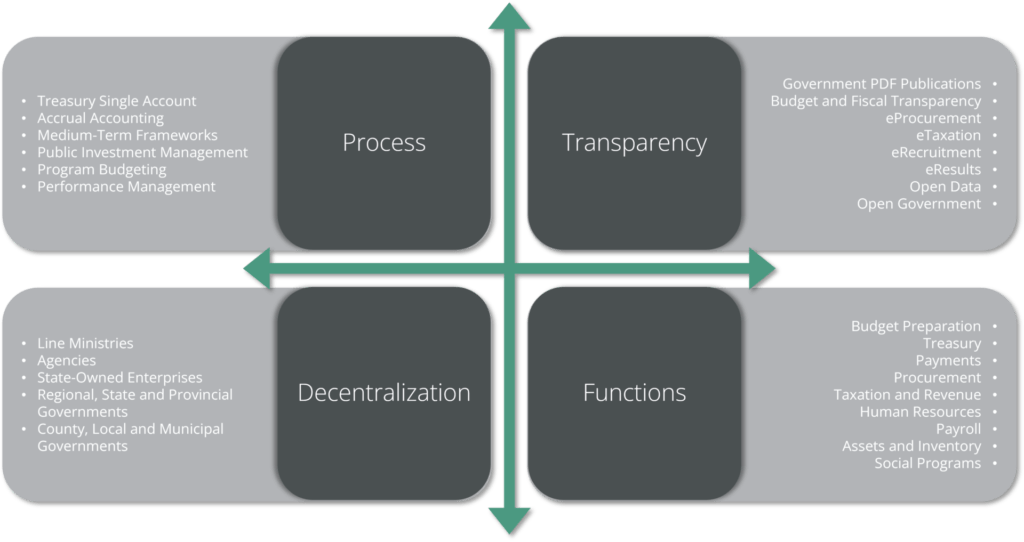How Does Progressive Activation Deliver Public Financial Management Reform?
The Importance of Technology in Government
Technology such as Government Resource Planning (GRP) solutions that are used as Integrated Financial Management Information Systems (IFMIS) for government, is seen as an expression of Public Financial Management (PFM) reform.
Diamond and Khemani suggest that “the establishment of an IFMIS has consequently become an important benchmark for the country’s budget reform agenda, often regarded as a precondition for achieving effective management of the budgetary resources. Although it is not a panacea, the benefits of an FMIS could be argued to be profound.”
While there is general agreement that PFM and institutional reform is critical to improving governance, the pace of reforms often slows because of the inability of information systems to adapt to new needs. Furthermore, there is no standard best practice in terms of sequencing of reforms because different country contexts mean different needs.
That is why FreeBalance follows a progressive activation approach – continued and sustained activation of required PFM functionality based on country governance needs.
How do Government Resource Planning Systems Help With Public Financial Management Reform?
GRP systems, such as FreeBalance Accountability Suite™, support automated governance tools that enforce fiscal procedures and help to improve efficiency and performance. Features of the GRP optimize government capacity and methodologies ensure capacity building as part of the professionalization of the public service.
Governance tools are progressively activated overtime to enable more advanced functions in sequence with improved capacity which ultimately leads to improved government performance and service delivery.
What is Progressive Activation?
The GRP “progressive activation” lifecycle can be described as:
- Technical GRP Platform consisting of one of more modules is installed in a government organization after a thorough needs analysis
- This needs analysis is used in a system configuration to meet government PFM needs
- Governments modernize and create new PFM laws through legal reform that can include new procurement guidelines, transparency initiatives and compliance with international standards such as the IMF Fiscal Transparency Code
- Governments also develop improved processes through process re-engineering
- Governments build civil service capacity to improve fiscal discipline and efficiency
- These changes require functional improvements that need to be configured in the GRP Platform that can include more advanced functions and new modules
- A typical initiative is to improve citizen delivery and decision-making through decentralization that requires some devolution of responsibilities yet maintaining budget controls
- Government Performance Management functions such as audit enables governments to identify opportunities for governance improvements in areas such as anti-corruption, risk management and efficiency improvements
- Dashboards and other analytical methods also identify opportunities for reform
- Progressive Activation enables sustainable PFM reform as the cycle returns to GRP Processes where the GRP system can adapt to multiple stages of reform

GRP Governance Toolset
There are GRP governance tools operating at every stage in the PFM reform lifecycle including:
Controls
- Chart of Accounts that aligns all government financial activity to budgets, users, purpose, organizational structure and accounting types for fiscal discipline – the COA tends to change because of government reform to introduce program budgeting, performance measures, standards support or accrual accounting
- Segregation of Duties ensures proper fiscal discipline – duties tend to change as governments decentralize, and reorganize
- Integration ensures that controls and functions operate consistently across multiple modules – integration requirements tend to increase as new modules and users are added
- Procedure Workflow articulates proper processes and controls – the workflow tends to change as governments introduce more advanced functional
Tools
Some governance tools augment specific parts of progressive activation lifecycle:
- Needs analysis is augmented by methodology tools that generate system blueprints (that often include multiple stages) following appropriate good practices
- Configuration includes changing parameters, adding fields of information, adjusting business rules and workflow as part of controls
- Legal reform and process re-engineering is enabled through change management methodology tools that ensures appropriate reforms for the country context and effective socialization of those reforms – and the linkage with policy
- Capacity building is enabled through configuration controls including eLearning, user certification and localized help and terminology that adapts to meet increase in civil service knowledge
- Functional improvements require controls to upgrade parameters, information fields, business rules and workflow that includes typical initiatives like movement to accrual accounting
- Decentralization is supported through the configuration controls
- Auditing includes compliance and performance audits decision-making tools that provides information to eliminate practice deficiencies through controls and typically uses the technique of benchmarks within government and with peer governments
- Performance management includes results systems decision-making tools that enable connecting government spending with outputs and outcomes that can improve decisions and provide insight into controls changes
Progressive Activation Enablers
Institutional governance enablers that are critical to progressive activation include:
- Capacity of stakeholders including businesses, executive and civil society to create an environment for governance improvements
- Public Service capacity and incentives is important otherwise informal practices will dominate and laws will not be put into practices
- Political Will by stakeholders such as the executive and senior public servants to champion change
- Standards used in public financials that provides better information to stakeholders
- Accounting procedures used by the government that provides appropriate fiscal discipline using good practices and integrated with controls
- Compliance processes and norms within the government
There are other institutional characteristics that are important during the lifecycle, including:
- Legislature institutional capacity to ensure debate and passage of appropriate PFM laws
- Focus on improving the efficiency of government processes through automation and functional improvements
- Decentralization of appropriate controls to enable devolution and improved citizen services
- The independence and enforcement options for internal and external audit institutions and public service organizations to enable future reforms
It can be argued that appropriate institutional arrangements for PFM reform sequencing will have limited impact without an effective underlying technology system such as the FreeBalance Accountability Suite™:
- Auditors will be forced to track budget, revenue and spending effectiveness through paper files or across incompatible information systems
- Public servants will not have access to data that measures efficiency or effectiveness in order to recommend changes
- Informal processes will dominate public financial management without automated controls
- Errors in financial processing will not be easily trapped except with an automated system that will show where user capacity needs improvement
Progressive Activation and PEFA Assessments
Progressive activation using GRP with tools and enablers will help to improve ratings for:
- PEFA B Comprehensiveness and Transparency
- PI-5 budget classification could be improved to support program budgeting, reorganization, performance indicators and accrual accounting
- PI-6 increase in the comprehensiveness in budget documents thanks to improved data classification
- PI-7 reduced amount of unreported government operations through decentralization and integration
- PI-8 improved transparency of inter-governmental fiscal relations through decentralization and integration
- PEFA C(ii) Predictability and Control in Budget Execution
- PI-16 improved predictability in the availability of funds for commitment of expenditures through improved budget classification and controls
- PI-17 automation to improve the recording and management of cash balances, debt and guarantees
- PI-20 improved effectiveness of internal controls thanks to effective automated controls
- PEFA C(iii) Accounting, Recording, Reporting
- PI-22 improved timeliness of accounts reconciliation via integration and automation including integration across GRP modules
- PI-23 improved availability of information from service delivery units through increased GRP coverage government-wide
- PI-24 improved quality and timeliness of in-year reports through integration, automation and the use of international standards and good practices in accounting procedures
- PI-25 improved quality and timeliness of in-year reports through integration, automation and the use of international standards
- PEFA C(iv) External Audit and Scrutiny
- PI-26 improved scope of external audit through independence, capacity and access to the procurement audit trail
- PI-28 improved legislative scrutiny of external audit reports because of improved information and increased legislator capacity
Conclusions
The pace of PFM reform needs to be sustainable to have lasting governance improvements. The information systems used must enable rather than prevent reform. There have been numerous failures when inappropriate software is used for government financial management.
GRP software such as the FreeBalance Accountability Suite™ enables reform through:
- Progressive activation of business rules and workflow to support modernization
- Integration of additional software modules that increases automation across government
- Decentralization of processes and responsibilities in concert with capacity improvements
- Government-specific methodologies for needs analysis and change management that includes tackling incentives and informal practices
These tools and techniques are best leveraged by governments with political will, good civil service, legislative and civil society capacity with audit organizations with sufficient capacity, independence and enforcement.
To speak to a Public Financial Management expert about FreeBalance’s approach to progressive activation, please get in touch.
